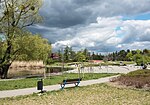Wolska Street, Warsaw
Streets in WarsawWarsaw stubs

Wolska (Polish: Ulica Wolska, lit. Wola Street) is the main artery of Warsaw's borough of Wola. Initially Wola district was but a western suburb of Warsaw and a road leading to it was dubbed "droga wolska" - Wola road. In 1725 parts of that road closest to the Warsaw Old Town, located along the Saxon Axis, were officially renamed to "Aleja Wolska" - Wola Avenue. In modern times it starts at a crossing of Chłodna and Towarowa Streets, and runs as a continuation of Solidarity Avenue through the neighbourhoods of Młynów, Czyste and Ulrychów, all the way to Połczyńska Street.
Excerpt from the Wikipedia article Wolska Street, Warsaw (License: CC BY-SA 3.0, Authors, Images).Wolska Street, Warsaw
Wolska, Warsaw Wola (Warsaw)
Geographical coordinates (GPS) Address Nearby Places Show on map
Geographical coordinates (GPS)
| Latitude | Longitude |
|---|---|
| N 52.2303 ° | E 20.954 ° |
Address
Wolska 111
01-235 Warsaw, Wola (Warsaw)
Masovian Voivodeship, Poland
Open on Google Maps









